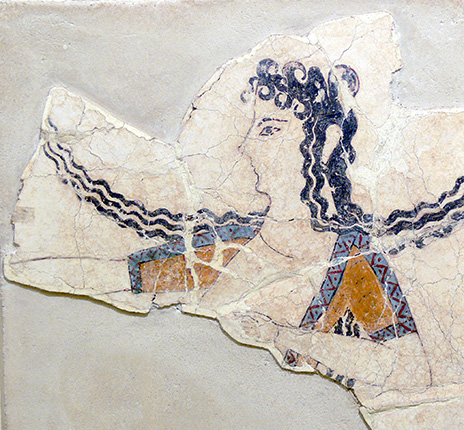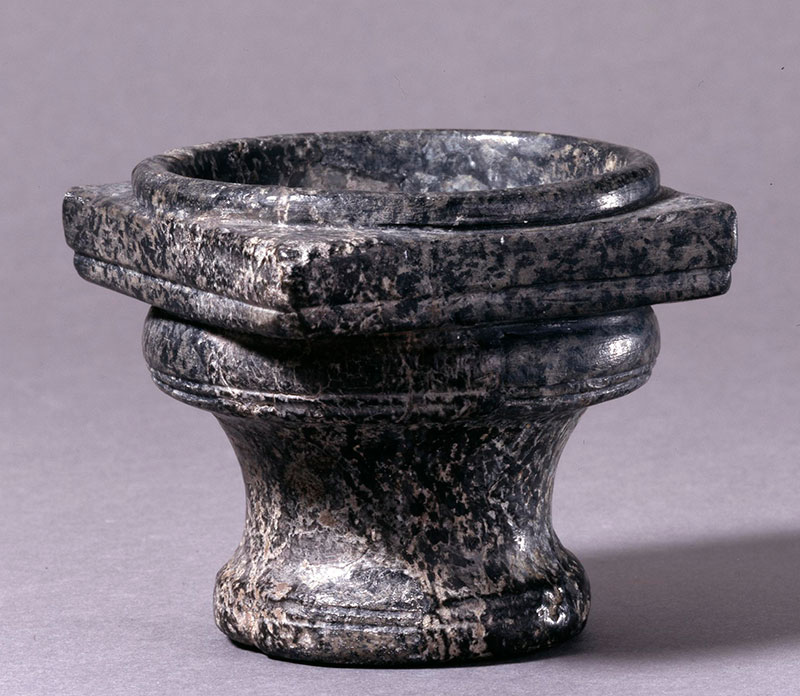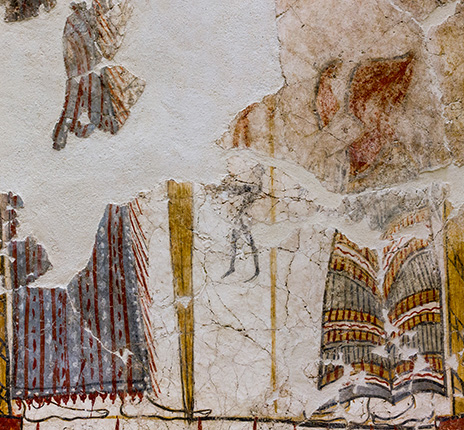This page is temporary and meant to share what I’ve learned so far. Eventually I will have meanings, sources, and more solid derivations for each name.
Names from: Crete | Mycenae | Pylos
Names from Crete
Non-Greek names from Crete are likely to be Hellenized versions of Minoan names.
| Name in Linear B | Greek Version | Derivation |
|---|---|---|
| *34-zo | Minoan? | |
| *49-so | Minoan? | |
| a3-ki-po | ||
| a3-ki-si-jo | ||
| a3-ko-ta | Aigortās | Greek |
| a3-ku-pi-ti-jo | Aiguptios | Greek |
| a3-ni-jo | Probably Greek | |
| a3-qo-ta | Probably Greek | |
| a3-wa-to | Probably Greek | |
| a-da-ra-ro | ||
| a-di-nwa-ta | ||
| a-di-ri-jo | Andrios or Andrōn, or from a place name | Greek |
| a-du-ru-po-to | Adruptios | Possibly Minoan |
| a-ka-de | ||
| a-ka-sa-no | Alksānōr (cf. Ἀλξήνωρ) | Greek |
| a-ka-to | Agathos or Agathōn or possibly Akanthos | Greek |
| a-ka-to-wa | Greek | |
| a-ke-ta | Agetās or Akestās | Greek |
| a-ke-u | ||
| a-ki-wa-ta | ||
| a-ko-ra-jo | Agoraios | Greek |
| a-ku-ri-jo | ||
| a-ma-no | ||
| a-me-ja-si | ||
| a-mi-ni-so? | ||
| a-na-qo-ta | ||
| a-no-qo-ta | Anorq(h)ontās | Greek |
| a-nu-mo | ||
| a-nu-to | ||
| a-nu-wi-ko | ||
| a-pa3-da-ṛọ (a-*56-da-ṛọ) | Minoan | |
| a-pa3-no (a-*56-no) | Minoan | |
| a-pi-da-ta | Amphidaitās | Greek |
| a-pi-me-de | Amphimēdēs | Greek |
| a-pi-ra-wo | Amphilāwos or Amphilawōn | Greek |
| a-pi-wa-to | Greek | |
| a-qa-to | ||
| a-qi-ru, a-qi-ro | Minoan | |
| a-ra-da-jo | Possibly Minoan | |
| a-ra-ka-jo | Possibly Minoan | |
| a-ra-ko | Possibly Minoan | |
| a-ra-na-ro | Minoan | |
| a-ra-so | Minoan? | |
| a-re-ị -me-ne, a-re-me-ne | Greek | |
| a-re-ke-se-u | Alexeus | Greek |
| a-re-ta-wo | ||
| a-re-te-re-u | ||
| a-sa-ro | ||
| a-si-wi-jo | Aswios | non-Greek? |
| a-so-qi-jo | ||
| a-ta | ||
| a-ta-ma-ta | ||
| a-ta-no | Antanōr | Greek |
| a-ta-qe | ||
| a-ta-ze-u | ||
| a-te-jo | ||
| a-te-mo | ||
| a-ti-jo | ||
| a-ti-ka | ||
| a-to | ||
| a-tu-ko | Atukhos | Greek |
| a-tu-qo-ta | ||
| au-ri-jo | ||
| a-wa-so | Minoan? | |
| a-wi-to-do-to | ||
| da-da-re-jo-de | Minoan | |
| da-i-mi-so | Minoan? | |
| da-i-pi-ta? | ||
| da-i-qo-ta | Dā(h)ik(w)hontās | Greek |
| da-i-ta-ra-ro | Possibly Minoan | |
| da-ko-so | ||
| da-ra-mu-ro | Possibly Minoan | |
| da-ro | ||
| da-wa-no | ||
| da-wa-no | ||
| da-we-ro | ||
| da-zo | ||
| de-ke-se-u | Dexeus or Derxeus | Greek |
| de-u-ke-ro | ||
| di-de-ro | Minoan | |
| di-du-me, di-du-mo | Possibly Minoan | |
| di-ka-ta-ro | Minoan | |
| di-ra | ||
| di-ta-ka-so | Minoan? | |
| di-we-so | ||
| di-wi-ja-wo | Diwyāwōn | Greek |
| di-wo | Diwōn | Greek |
| di-za-so | Minoan? | |
| di-zo | ||
| do-ri-jo | ||
| do-ri-ka-no | ||
| do-ti-jo-no | ||
| du-ni-jo | ||
| du-pu2-ra-zo | Minoan | |
| du-ru-po | ||
| du-ta-so | Minoan? | |
| du-to | ||
| du-to | ||
| e-ke-a | ||
| e-ke-me-de | Greek | |
| e-ke-se | ||
| e-ki-no | Ekhinos | Greek |
| e-mi-ja-ta | Possibly Minoan | |
| e-ne-ke-se-u | Enexeus | Greek |
| e-ri-ke-re-we | Eriklewēs | Greek |
| e-ri-ta-qi-jo | Possibly Minoan | |
| e-ru-to-ro | ||
| e-se-re-e-jo | ||
| e-te-wa-tu-wo | ||
| e-u-da-i-ta | E(h)udaitās | Greek |
| e-u-da-mo | ||
| e-u-ko-ro | Possibly Eukolos or Eukoros or Euklos | Greek |
| e-u-me-ta | Eumetās | Greek |
| e-u-na-wo | Eunāwos | Greek |
| e-we-de-u | ||
| i-da-ra-ta | ||
| i-ke-ta? | ||
| i-ne-u | ||
| i-ro-to | ||
| i-se-we-ri-jo | ||
| i-te-u | ||
| i-to | ||
| i-to-ma | ||
| i-wa-ka | ||
| i-wa-ko | ||
| i-we-ro | ||
| i-za-re | ||
| ja-ma-ra | Possibly Minoan | |
| ja-pa-ra-ro | Possibly Minoan | |
| ja-ra-to | Minoan? | |
| ja-sa-no | Possibly Minoan | |
| ja-sa-ro | ||
| ja-sa-ro, a-sa-ro | Possibly Minoan | |
| ja-ti-ri | Possibly Minoan | |
| je-zo | Minoan? | |
| ka-da-i-so | Minoan? | |
| ka-da-no | ||
| ka-ke | ||
| ka-mu-ko-to | ||
| ka-na-po-to | ||
| ka-nu-se-u | ||
| ka-pa3-na-to (ka-*56-na-to) | Minoan | |
| ka-pa3-no | Minoan | |
| ka-pa-ri-jo | ||
| ka-ra-i-no? ka-ra-i? | ||
| ka-ra-na-ko | ||
| ka-ri-se-u | Khariseus | Greek |
| ka-sa-no | Kassānōr | Greek |
| ka-sa-ro | Minoan | |
| ka-sa-ro | ||
| ka-ta2-ro | ||
| ka-to | Kastōr | Greek |
| ke-ka-to | Kekastos | Greek |
| ke-ra-ja | ||
| ke-re | ||
| ke-re-to | ||
| ke-sa-do-ro | Kessandros | Greek |
| ke-u-sa | Minoan? | |
| ke-we-da | ||
| ki-*18-i-so | Minoan? | |
| ki-ke-ro | ||
| ki-ke-ro, ki-ke-ru | Possibly Minoan | |
| ki-ma-ta | ||
| ki-mu-ku, ki-mu-ko | Minoan? | |
| ki-ri-ja-si | ||
| ki-si-wi-jo | ||
| ki-ta-ne-to | ||
| ki-u-ro | ||
| ko-a-ta | ||
| ko-ki-da | ||
| ko-ku | Kokkux | Greek |
| ko-ku-ro | ||
| ko-me-no? | ||
| ko-ni-da-jo | Possibly Minoan | |
| ko-pe-re-u | Kopreus | Greek |
| ko-ro | Minoan | |
| ko-sa-ma-to | ||
| ko-so | ||
| ko-so-ne | Korsos? | Minoan? Greek? |
| ko-to | ||
| ku-da-jo | Possibly Minoan | |
| ku-i-so | Minoan? | |
| ku-ka-da-ro | Minoan | |
| ku-ka-ro | Minoan | |
| ku-ka-so | Minoan | |
| ku-ke-so | Minoan? | |
| ku-mi-so | Minoan? | |
| ku-mo-no-so | Minoan? | |
| ku-ne-u | Kuneus | Greek |
| ku-ni-ta | ||
| ku-pa-nu-we-to | ||
| ku-pe-re-te | ||
| ku-pe-se-ro | ||
| ku-ra-no | ||
| ku-ro2 | Kúlos Κύλος | Greek |
| ku-ru-me-ni-jo | Klumenios | Greek |
| ku-ru-no | ||
| ku-ta-i-jo | ||
| ku-ta-si-jo | Kutasios | Greek |
| ku-te-ro | Could this be Κύθηρος? See Kutereu. | |
| ku-to | ||
| ma-di | Minoan | |
| ma-di-qo | ||
| ma-ja-ro | ||
| ma-ke-ra | ||
| ma-ke-ra-mo | ||
| ma-ma-ro | Mármaros | Greek |
| ma-ro(?) | Minoan | |
| ma-ta-u-ro | ||
| ma-ti-jo | ||
| ma-ti-ko | ||
| me-de-i-jo | ||
| me-nu-wa | ||
| me-to-re | Mestorēs | Greek |
| me-wo-ni-jo | ||
| mi-ja-ra-ro | Probably Minoan | |
| mi-ru-ro | ||
| mi-ti | Minoan | |
| mo-qo-so | Mokwsos | non-Greek |
| na-pu-ti-jo | Nāputios | Greek |
| na-pu-ti-jo | ||
| na-ru | Nārus | Minoan? |
| na-si-jo | ||
| na-wi-ro | Nāwilos | Greek |
| ne-o-ta | ||
| ne-o-to | ||
| ne-ri-wa-to | ||
| ne-ti-ja-no | Nestianōr | Greek |
| no-da-ro | Possibly Minoan | |
| no-da-ro | Possibly Nōdaros | Greek? |
| no-da-ro? | Minoan | |
| no-si-ro | Possibly Minoan | |
| o-*22-di? | Minoan | |
| o-ku-na-wo | Ōkunāwos | Greek |
| o-ku-no | Ōkunos | Greek |
| o-pe-ta | ||
| o-pi-ri-mi-ni-jo | Greek | |
| o-pi-si-jo | Opsios | Greek |
| o-po-ro-u-si-jo | ||
| pa3-ni-sa-ta (*56-ni-sa-ta) | Minoan | |
| pa-ja-so | Minoan? | |
| pa-ke-ta | ||
| pa-na-re-jo | Panareios | Greek |
| pa-pa-ro | Possibly Minoan | |
| pa-qo-si-jo | Pagg(w)ōsios | Greek |
| pa-ra-to | Platōn or Phalanthos | Greek |
| pa-ta-u-na | ||
| pa-ti | Possibly Minoan | |
| pa-wi-no | ||
| pe-qo-no | ||
| pe-re-*82-ta | ||
| pe-re-ko | ||
| pe-re-te-u | ||
| pe-ri-ta | ||
| pe-ro-qe? (or is this pe-ro?) | ||
| pe-te-ki-ja | ||
| pe-te-u | ||
| pe-we-ri-jo | ||
| pi-ja-se-me | Probably Minoan | |
| pi-ja-si-ro | Probably Minoan | |
| pi-ja-to | Probably Minoan | |
| pi-ma-na-ro | Possibly Minoan | |
| pi-ri-no | ||
| pi-ri-no | Philinos | Greek |
| pi-ri-u-wo | ||
| pi-ro-qa-wo | ||
| pi-sa-wa-ta | ||
| po-ki-te | ||
| po-me | Poimēn | Greek |
| po-ro | Polos | Greek |
| po-ro-u-te-u | Plouteus | Greek |
| po-ru-qo-to | Polug(u)otos | Greek |
| po-ti-jo | ||
| po-to | ||
| po-to-ri-jo | Ptoliōn | Greek |
| pu2-ra-ne-jo | ||
| pu2-ru-da-ro | Possibly Minoan | |
| pu-da-so | Minoan? | |
| pu-na-si-jo | Possibly Minoan | |
| pu-na-to | ||
| pu-nu-so | Minoan? | |
| pu-re-wa | ||
| pu-ri | Possibly Minoan | |
| pu-te | ||
| pu-to-ro | ||
| pu-wo | Purwos | Greek |
| qa-da-ro | Possibly Minoan | |
| qa-da-so | Quādasos | Minoan |
| qa-me-si-jo | ||
| qa-me-si-jo (originally written pa2-me-si-jo) | non-Greek? | |
| qa-nu-wa-so / qa-nwa-so | Minoan? | |
| qa-qa-ro | Minoan | |
| qa-ra2-ti-jo | K(w)alyantijos? | Greek |
| qa-ra-i-so | Minoan? | |
| qa-ra-jo | ||
| qa-ra-su-ti-jo | ||
| qa-sa-ko | K(w)āsark(h)os | Greek |
| qa-si-da-ro | Minoan? | |
| qa-ti-ja | Kwā(s)tiās | Greek |
| qa-to-no-ro | ||
| qe-ri-jo | ||
| qe-ro | ||
| qe-te-se-u | ||
| qi-ja-zo | Minoan? | |
| qi-ni-te-we | ||
| qi-nwa-so | Minoan? | |
| qi-qe-ro | ||
| qo-te-ro | ||
| qo-wa-ke-se-u | ||
| ra-ni | Possibly Minoan | |
| ra-sa-to | ||
| ra-wi-zo | Minoan? | |
| ra-wo-qo-no | Greek | |
| re-ka-ta | ||
| re-ko-no | ||
| ri-ma-zo | Minoan? | |
| ri-wi-so | Minoan? | |
| ri-zo | ||
| ru-na | Lurnās | Lurnās |
| ru-na-so | Lurnassos | |
| ru-pa3-ra-so (ru-*56-ra-so) | Minoan | |
| ru-ro | ||
| sa-ma-ja-so | Minoan? | |
| sa-ma-ri-jo | Samarios | Probably Minoan |
| sa-ma-ri-wa-ta | Possibly Minoan | |
| sa-pi-ti-nu-wo | ||
| sa-qa-re-jo (originally written sa-pa2-re-jo) | ||
| sa-sa-jo | Minoan? | |
| sa-u-ri-jo | ||
| sa-za-ro? | ||
| sa-zo | Minoan? | |
| se-ri-na-ta | ||
| si-ja-du-we | ||
| si-ja-ma | Possibly Minoan | |
| si-ja-ma-to | Possibly Minoan | |
| si-ja-pu2-ro | Possibly Minoan | |
| si-ja-qo | ||
| si-ki-to | Minoan | |
| si-mi-do | ||
| si-mi-te-u | Smintheus | Greek |
| si-pu2 | ||
| si-ra-ko | ||
| si-re-wi-ja | ||
| si-ta-ro | Minoan | |
| si-za | ||
| su-ke-re | ||
| su-ki-ri-to | ||
| su-ma-no | ||
| su-mi | Possibly Minoan | |
| su-po | Minoan | |
| su-pu-wo | ||
| su-ru-so | Minoan? | |
| su-ta-no | ||
| ta-de-so | Minoan? | |
| ta-di-*22-so | Minoan | |
| ta-mi-de-so | Minoan? | |
| ta-na-po-so | Minoan? | |
| ta-na-to | Minoan | |
| ta-pa-da-no | ||
| ta-si-ko-no | ||
| ta-so | Minoan? | |
| ta-ta-ro | Possibly Minoan | |
| ta-to | ||
| ta-u-na-so | Minoan? | |
| ta-u-po-no | ||
| ta-u-ro | ||
| ta-za-ro | ||
| te-ra-po-si-jo | ||
| te-ru-sa | Minoan? | |
| ti-mi-za | Minoan? | |
| ti-qa-jo | Thisg(w)aios | Greek |
| ti-ri-jo-ko-so | Possibly Tri-oxos | Minoan? Greek? |
| ti-ri-to | ||
| to-na-ta | ||
| to-pe-si | ||
| to-ro-ki-no | ||
| to-ro-wo | ||
| to-wa-no | Thowānōr | Greek |
| tu-da-ra | Tundarās | Minoan? |
| tu-ma-da-ro | Minoan? | |
| tu-ma-i-ta | ||
| tu-pa3-da-ro (tu-*56-da-ro) | Minoan | |
| tu-qa-ni-ja-so | Minoan? | |
| tu-wi-no | ||
| u-ra-jo | ||
| u-ra-mo-no | ||
| wa-du-na-ro | Possibly Minoan | |
| wa-du-na-ro; wa-du-na | Minoan | |
| wa-du-na-to | Possibly Minoan | |
| wa-ru-wo-qo | ||
| wa-si-jo-ne | ||
| wa-ti-jo (personal name?) | ||
| we-ka-di-jo | ||
| we-ro-pa-ta | ||
| wi-da-jo | Possibly Minoan | |
| wi-da-ka-so | Minoan? | |
| wi-du-ro | ||
| wi-ja-ma-ro | Possibly Minoan | |
| wi-je-mo | ||
| wi-je-so | Minoan? | |
| wi-jo-qo-ta | Greek | |
| wi-ra-ne-to | ||
| wi-ri-ki-no | ||
| wi-ro | ||
| wo-di-jo | Wordios | Greek |
| wo-ne-wa-ta | ||
| zo-do-so? | ||
| zo-wi-jo | Zōwios | Greek |



